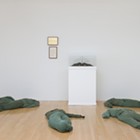Dave Martin wanted to know why, exactly, he had adenoid cystic cancer in his mouth.
He didn’t smoke. He didn’t chew tobacco. He lived a healthy life — he drank lots of milk, he ate all his vegetables. So why, he asked the doctors at the University of Washington, did he have cancer?
Because he drank lots of milk and ate his vegetables, they theorized. Martin lived the first seven years of his life near the Hanford Nuclear Reservation.
In the 1940s, milk from cows downwind from the site had a secret ingredient: radioactive iodine-131, a byproduct of plutonium production for the atomic bomb. Prevailing breezes dispersed the iodine radioisotopes throughout the Palouse grassland. That iodine went from cow fodder to cow udder to the dinner table.
In heavy doses, iodine-131 can pummel the thyroid, possibly causing thyroid cancer, thyroid nodules or hypothyroidism. While Martin never had thyroid cancer, the doctors believed his adenoid cystic cancer originated from a troubled thyroid.
While the government said plutonium processing could release troublesome materials in 1945, they promised safety protocols prevented “the slightest possibility of danger” to civilians. The public only found out about the scope of radiation — 400,000 curies worth — when environmental impact documents were released in 1986.
Once they discovered how much radiation had been expelled from Hanford, many “downwinders” suffering from cancer and other maladies joined together and filed a suit against Hanford contractors DuPont and General Electric. Martin was one of those plaintiffs.
Almost 19 years later, there’s still no resolution and Dave Martin will never see one. He died Sept. 17, 2005, and his story is told by his wife, Darlene — who has continued the lawsuit. “I did promise him I would follow through with it, and keep it alive,” she says.
In 1998, a judge dismissed 90 percent of the case, but the 9th Circuit Court of Appeals rejected that judge’s reasoning, resurrecting the entire case. The lawsuit morphed into a “bellwether” approach — an examination of 12 representative cases out of the 3,600 — but another round in the 9th Circuit sent three of those cases back to trial. Just recently, the U.S. Supreme Court refused to hear an appeal from the defense arguing that the contractors, as servants of the government, weren’t liable.
Still, the companies being sued won’t have to pay a dime. No, due to a government agreement, any damages awarded — and the $50 million-plus legal bill of the defense — come out of the taxpayers’ wallets.
To Richard Eymann, a lawyer representing downwinders, such a long drawn-out, expensive case is maddening. It means more people die, without receiving restitution. “A debt was incurred back then to people that were totally innocent,” Eymann says. “For the people who have already died, they’ll never see it.”
The cost to the defense firms keeps piling up. While defense attorneys can bill more hours — and make more money — the longer the case drags on, Eymann only gets paid when his plaintiffs win. Eymann estimates around $10 million has been spent by plaintiff firms so far. What have they seen for their investment? Compensation given to only two plaintiffs, totaling little more than $500,000.
“The case is a disaster for the plaintiffs,” Kevin Van Wart, the attorney representing the contractors, says.
To Van Wart, such an expensive case is also maddening. He accuses the downwinders of packing their case with hundreds of frivolous “junk” claims, slowing it down. Only 300 have thyroid cancer. The others have thyroid nodules, hypothyroidism or more than 20 other types of cancer. Plaintiffs blame not just iodine, but cesium, strontium and other radionuclides.
“The plaintiffs’ lawyers went wild and began signing up thousands of peoples en masse,” Van Wart says. Indeed, Eymann says the number of plaintiffs dropped from 3,600 to 2,200 after a number of their claims were found to be inaccurate.
“There needs to be a process to identify the better claims for the ones that deserve compensation,” Van Wart says.
While the presiding judge, William Fremming Nielsen, presses for a resolution, reaching a settlement will be challenging. There’s a fundamental disagreement over the science.
“There was no evidence in the 1940s and no evidence today... that the Hanford plant harmed anyone,” Van Wart says. He cites a study from the Fred Hutchinson Cancer Research Center finding no link between levels of Hanford radiation and thyroid cancer rates. But that study is based on an exposure model — the Regional Transport Code for Hanford Emission Tracking — that Eymann says is flawed.
For the past year, Van Wart has had a settlement offer on the table. Every thyroid cancer victim with more than 10 rads of exposure would receive $150,000. Lesser awards would go to highly irradiated plaintiffs with thyroid nodules or hypothyroidism. To Eymann, such a low number is insulting. Darlene Martin feels the same way.
“The price of [Dave’s] drugs was out of this world,” Darlene says.
Yet at the same time, Darlene says she doesn’t know what dollar amount would be fair. “How do you put a number on a person’s life? He was my best friend. He was everything to me,” she says.
If no agreement can be reached, Eymann says the standoff will continue to drag on. “That’s great for the defendants,” Eymann says. “That’s not good for the taxpayers. That’s not good for the people who waited all these years.”




















